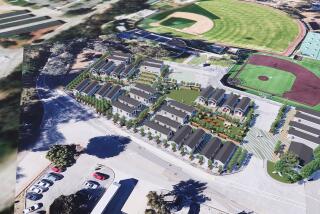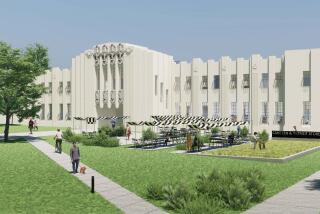Park to be tested for radiation
Relenting to community concerns, the federal government announced this week it will perform tests on a Brentwood dog park and nearby grounds where Veterans Administration and UCLA researchers buried radioactive medical waste during the Cold War.
The decision comes after environmentalists and community activists spent years researching the activities, saying they found higher than average levels of radiation at the park and a nearby athletic field -- used by the exclusive Brentwood School -- as well as in nearby canyons and ravines.
For the record:
12:00 a.m. Dec. 1, 2006 For The Record
Los Angeles Times Friday December 01, 2006 Home Edition Main News Part A Page 2 National Desk 1 inches; 65 words Type of Material: Correction
Brentwood park testing: Two photo captions accompanying an article in Thursday’s California section about underground dumping on federal property on the Westside of Los Angeles incorrectly implied that the photos showed workers doing testing at a Brentwood dog park and athletic field. The workers were taking sample tests on a nearby property that could be compared to the tests conducted at the park and field.
For The Record
Los Angeles Times Wednesday December 06, 2006 Home Edition Main News Part A Page 2 National Desk 1 inches; 61 words Type of Material: Correction
Brentwood dump: A story in the Nov. 30 California section said a study offering new details on a former nuclear dump at the Barrington Dog Park and surrounding areas in Brentwood was conducted by PricewaterhouseCoopers. The study was conducted by MicroTech LLC, a separate company hired by the Department of Veterans Affairs, and its findings were contained in PricewaterhouseCoopers’ broader report.
They believe the charred carcasses of animals used in radiation experiments, as well as barrels of radioactive tritium and other toxic chemicals, are underground.
Veterans Affairs officials said this week that they doubt harmful levels of radioactivity will be found, noting the government performed tests before the dog park and athletic fields were built.
“We want to put everyone’s fears to rest and reassure everyone that there isn’t any danger,” said Shana Boehm, a program analyst for the VA in Westwood.
From 1952 to 1968, UCLA and the then-Veterans Administration used the northwest corner of the property to dump radioactive biomedical research waste, officials have acknowledged.
The 387-acre VA grounds along Wilshire Boulevard just west of the 405 Freeway is considered prime underdeveloped real estate and is being studied for development by the federal government to better utilize inefficient VA property.
Since 1985, 12 acres have been leased to the city of Los Angeles for $1 a year for the Barrington Recreation Center, and a section of the property was made into Barrington Dog Park in 2003.
A portion of the off-leash area contains part of the former nuclear dump.
Critics fear any future development could result in digging in and around the dump area, unleashing toxins, unless the pollutants are found and cleaned up.
Revelations about the dumping program came to light in the 1970s when the nuclear watchdog group Committee to Bridge the Gap became aware that the city was negotiating with the VA to convert some of the property into a park. In 1981, after conducting its own research, the group pointed out that some of the main radionuclides at the site included tritium and carbon-14.
But the Nuclear Regulatory Commission dismissed those concerns and concluded the property posed no health risks. Based on that assessment, the L.A. Department of Recreation and Parks moved forward with its plans to build the park.
The dumping was largely forgotten until earlier this year when reporter Michael Collins, writing for the alternative weekly Los Angeles City Beat and EnviroReporter.com, raised new concerns about the dump area. Collins said in the story that he used a nuclear radiation monitor and found “shards of radioactive glass that registered over four times normal.”
In addition, a preliminary report conducted by PricewaterhouseCoopers last year for the VA offered new details on the nuclear dump, including the revelation that radioactive medical waste and asbestos are buried 15 to 30 feet beneath areas leased to the Brentwood School for use as athletic fields.
“Either the public was not informed as to the contaminates under the athletic fields, or these environmental hazards did not trigger a significant negative public reaction from nearby residents (including parents of students using the fields),” the report stated.
Since that information became public, community activists and local leaders have pressured the VA to further investigate what may have been buried in the once-empty fields.
Rep. Henry A. Waxman (D-Los Angeles) wrote to the secretary of the Department of Veterans Affairs in Washington earlier this year, demanding answers to questions about 10 underground storage tanks on the property.
Specifically, Waxman asked when the tanks were last checked for leaks and whether there are other hazardous materials at the West L.A. veterans property.
A spokeswoman for Waxman said the department has not replied to his questions.
In a public meeting held Monday night to inform the public about the latest study, parents expressed concern for their children who play in the athletic fields and pet owners for their dogs, said Michael Noel, president of Millennium Consulting Associates, which was hired by the VA to conduct the study.
Few complete records of what was disposed are available, partly because extensive documentation was not required before 1970, Noel said.
“We need to get to the bottom of this and find out what was buried, when it was buried and how much was buried,” said Noel, adding that it may be impossible to definitively answer the final question.
“The more important thing is whether what’s buried there poses a risk to the community and to the environment,” he said.
This week and next, Noel will be mapping the 25 to 30 acres in question to prepare for radiation measurements. He will have a preliminary report by the end of January.
Next spring, survey crews will begin drilling 80 feet into the ground for samples to test for radiation and other toxic materials.
Groundwater testing also will be done, including digging monitoring wells to check for contaminants, he said.
Millennium Consulting will receive $78,500 for the first phase of the study, Boehm said.
Norman Kulla, district director for City Councilman Bill Rosendahl, who represents the area, said the process will be “open and transparent,” including allowing the public to observe Noel’s fieldwork from “a safe distance.”
amanda.covarrubias
@latimes.com
More to Read
Sign up for Essential California
The most important California stories and recommendations in your inbox every morning.
You may occasionally receive promotional content from the Los Angeles Times.










